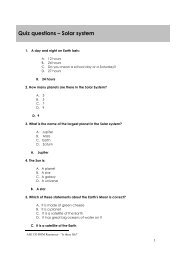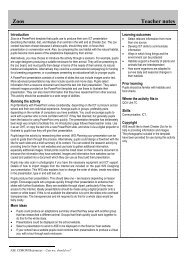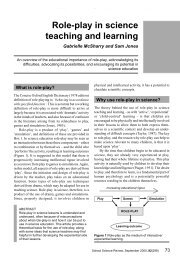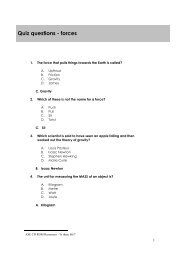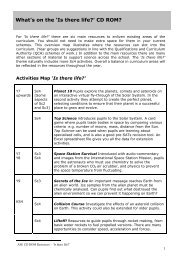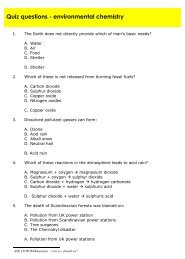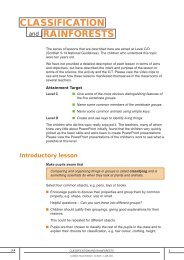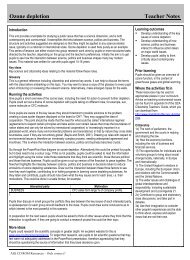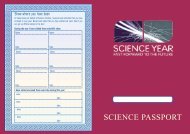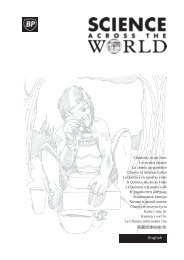Fun Size - ASE Science Year CD Roms Online
Fun Size - ASE Science Year CD Roms Online
Fun Size - ASE Science Year CD Roms Online
You also want an ePaper? Increase the reach of your titles
YUMPU automatically turns print PDFs into web optimized ePapers that Google loves.
<strong>Fun</strong> <strong>Size</strong>: Biobreakers<br />
Teacher notes<br />
Introduction<br />
This is similar to a well-known TV game for pupils. Questions in this version are<br />
biological.<br />
Running the activity<br />
Print the playing grids onto OHT sheets. There are twenty spaces on the grids.<br />
Players must answer a series of questions to win a line that starts in one coloured<br />
zone and reaches to the other zone of the same colour. Team 1 plays top to<br />
bottom, Team 2 plays left to right. A session consists of the best of three games<br />
using different grids.<br />
The quizmaster chooses the first letter. The first team to put up a hand may<br />
answer. An incorrect answer gives a chance for the opposing side to respond.<br />
Shouting out automatically forfeits the chance to answer. A successful answer<br />
gives the right to choose the next letter. If no successful answer then the<br />
quizmaster selects the next letter.<br />
Learning outcomes<br />
• Recall testing and vocabulary<br />
Where the activity fits in<br />
Review of Biology KS3 topics.<br />
Skills<br />
Team-work.<br />
Acknowledgements<br />
Thank you to the producers of similar<br />
games who suggested this activity.<br />
Please send your fun size games to<br />
nigel.heslop@scienceyear.com for<br />
inclusion on future <strong>CD</strong>ROMs.<br />
The teacher keeps track of questions answered correctly by marking the hexagon<br />
with a shaped counter, round for Team 1, triangular for Team 2. Teachers will<br />
need to make about a dozen of each shape of these counters.<br />
Select two teams. In the TV version one person plays against two others so the<br />
teams should not be of equal strength or size as Team 1 has only to answer four<br />
questions to win a game where as Team 2 has to answer five.<br />
Safety<br />
Not applicable.<br />
More ideas<br />
Pupils write their own questions at the end of a topic.<br />
<strong>ASE</strong> <strong>CD</strong>ROM Resources – ‘Who am I?’
TEAM 1<br />
o<br />
q<br />
e<br />
n<br />
b<br />
TEAM 2<br />
h<br />
i<br />
v<br />
s<br />
r<br />
c<br />
f<br />
t<br />
u<br />
p<br />
g<br />
l<br />
TEAM 2<br />
d<br />
m<br />
a<br />
TEAM 1
TEAM 1<br />
d<br />
s<br />
c<br />
i<br />
g<br />
TEAM 2<br />
f<br />
m<br />
o<br />
q<br />
v<br />
a<br />
h<br />
p<br />
t<br />
u<br />
r<br />
l<br />
TEAM 2<br />
b<br />
n<br />
e<br />
TEAM 1
TEAM 1<br />
e<br />
o<br />
m<br />
r<br />
d<br />
TEAM 2<br />
g<br />
s<br />
p<br />
h<br />
c<br />
a<br />
q<br />
i<br />
u<br />
b<br />
l<br />
f<br />
TEAM 2<br />
v<br />
t<br />
n<br />
TEAM 1
Biobreakers Questions<br />
Contestant(s) choose a letter from the chart.<br />
The teacher selects a suitable question for the team and marks it off.<br />
Questions should be asked in the form ‘This (A) means …’<br />
adolescence the time from child to adult<br />
aerobic<br />
respiration using oxygen<br />
anaerobic respiration without oxygen<br />
alimentary canal the food tube from mouth to anus<br />
animal<br />
one kingdom of living organisms<br />
antibiotic a medicine which kills bacteria<br />
aorta<br />
the main blood vessel from the heart<br />
artery<br />
a blood vessel that carries oxygenated blood<br />
asexual<br />
reproduction without a mate<br />
bacteria<br />
biceps<br />
bile<br />
biodegradable<br />
biomass<br />
biosphere<br />
capillary<br />
carbohydrate<br />
carbon dioxide<br />
cardiac<br />
carnivore<br />
cartilage<br />
cell<br />
chlorophyll<br />
chloroplasts<br />
cholesterol<br />
chromosome<br />
clone<br />
conservation<br />
contraction<br />
convex<br />
cytoplasm<br />
one type of very small organism<br />
a muscle in the arm<br />
a liquid that helps digest fat<br />
a material that rots naturally<br />
living material that is an energy resource<br />
where organisms survive<br />
a tiny blood vessel<br />
food for energy<br />
a gas we exhale<br />
to do with the heart<br />
meat eater<br />
tissue found in a joint<br />
smallest unit of a living thing<br />
chemical that absorbs light in photosynthesis<br />
structure in a cell where photosynthesis occurs<br />
fat that can clog arteries<br />
a structure that contains genes<br />
an identical organism<br />
keeping without needless losses<br />
a muscle getting shorter<br />
eye lens<br />
the jelly-like material in a cell<br />
<strong>ASE</strong> <strong>CD</strong>ROM Resources – ‘Who am I?’
decompose<br />
diabetes<br />
diaphragm<br />
diffusion<br />
digestion<br />
dilute<br />
ecosystem<br />
enzyme<br />
evolution<br />
excretion<br />
extinction<br />
fermentation<br />
fertilisation<br />
foetus<br />
food chain<br />
food web<br />
fossil<br />
gamete<br />
genes<br />
genetics<br />
germination<br />
glucose<br />
habitat<br />
haemoglobin<br />
herbivore<br />
hormone<br />
immunisation<br />
infra-red<br />
insulation<br />
invertebrate<br />
ligament<br />
liquid<br />
luminous<br />
lung<br />
to rot naturally<br />
a disease that produces uncontrolled blood sugar levels<br />
a muscle which contracts so that we can inhale<br />
slow spreading out of particles<br />
breaking down food<br />
not concentrated<br />
living and non-living factors interacting<br />
a biological catalyst<br />
very gradual change in a species<br />
removing waste from the body<br />
the death of a species<br />
making alcohol<br />
male and female sex cells joining together<br />
a baby before it is born<br />
the order that living things are eaten in<br />
many food chains linked together<br />
preserved remains of living things<br />
a sex cell<br />
a unit of genetic information<br />
the study of inheritance<br />
the start of growth from a plant seed<br />
a type of sugar<br />
where an organism lives<br />
the pigment in red blood cells<br />
a plant eater<br />
a chemical messenger carried in the blood<br />
a way of preventing disease<br />
heating rays<br />
material to prevent cooling<br />
an animal without a backbone<br />
a structure that holds bones together<br />
a state of matter with a fixed volume but no fixed shape<br />
something that gives out light<br />
an organ for gas exchange<br />
<strong>ASE</strong> <strong>CD</strong>ROM Resources – ‘Who am I?’
membrane<br />
menstrual<br />
microbe<br />
microscope<br />
mucus<br />
mutation<br />
nitrogen<br />
nucleus<br />
nutrients<br />
nutrition<br />
oesophagus<br />
omnivore<br />
organism<br />
ovary<br />
oxygen<br />
ozone<br />
parasite<br />
penicillin<br />
peristalsis<br />
photosynthesis<br />
placenta<br />
pollen<br />
pollution<br />
predator<br />
prey<br />
protein<br />
reproduction<br />
respiration<br />
result<br />
retina<br />
reversible<br />
saliva<br />
sensitive<br />
skeleton<br />
sodium<br />
species<br />
boundary layer around the cytoplasm of cells<br />
the monthly cycle of ovum release in a woman<br />
a very small organism<br />
the equipment we use to magnify very small things<br />
a slimy secretion<br />
a change in genes<br />
an element in proteins<br />
the control centre of a cell<br />
types of food<br />
taking in food<br />
the part of the gut from mouth to stomach<br />
an organism that eats animals and plants<br />
a living thing<br />
the organ in a woman that releases eggs<br />
the gas we need from air<br />
part of the atmosphere that protects us from UV radiation<br />
a harmful organism that lives on or in another living thing<br />
a type of antibiotic<br />
the way food is moved down the gut<br />
the process plants use to make food<br />
the structure that nourishes a baby in the uterus<br />
where the male sex cell is found in a plant<br />
unnatural materials in the environment<br />
an animal that hunts others for food<br />
an animal that gets eaten<br />
the type of food we need for growth and repair<br />
making another living thing<br />
the process that releases energy from food<br />
reading in an experiment<br />
light sensitive layer in the eye<br />
a reaction that can go the either way<br />
liquid produced in the mouth<br />
being able to detect changes<br />
the bones of the body<br />
metal part of common salt<br />
a group of living things which can reproduce together<br />
<strong>ASE</strong> <strong>CD</strong>ROM Resources – ‘Who am I?’
sperm<br />
stimulus<br />
stomata<br />
symbiosis<br />
tendon<br />
thorax<br />
thyroid<br />
tissue<br />
transpiration<br />
triceps<br />
ultrasound<br />
ultraviolet<br />
unsaturated<br />
urine<br />
uterus<br />
vacuole<br />
variation<br />
vertebrate<br />
virus<br />
vitamin<br />
male animal sex cell<br />
a change in the environment which can be sensed<br />
pores on the bottom surface of a leaf<br />
a feeding relationship where both organisms benefit<br />
part of the body that connects muscle to bone<br />
section of the body between neck and abdomen<br />
a gland in the neck<br />
lots of the same type of cells<br />
water evaporating from leaves<br />
an arm muscle<br />
waves beyond human hearing<br />
harmful waves that cause tanning<br />
a solution that dissolve more solute<br />
liquid excreted from kidneys<br />
the organ where an embryo develops<br />
where sap is stored in a plant cell<br />
differences between individuals<br />
an animal with a backbone<br />
a type of microorganism<br />
a type of nutrient<br />
<strong>ASE</strong> <strong>CD</strong>ROM Resources – ‘Who am I?’
<strong>Fun</strong> <strong>Size</strong>: <strong>Science</strong>, Technology and Reading<br />
Teacher notes<br />
Introduction<br />
Excerpt from the <strong>Science</strong>, Technology and Reading (STAR*) publication from<br />
<strong>ASE</strong>, which uses creative writing to stimulate debate.<br />
Running the activity<br />
Teacher notes from Star* are included in the pdf files<br />
Safety<br />
Not applicable.<br />
More ideas<br />
See STAR* notes.<br />
Learning outcomes<br />
See STAR* notes.<br />
Where the activity fits in<br />
KS3 ecology, pollution and<br />
environmental chemistry topics.<br />
Skills<br />
The STAR* notes refer to relevant<br />
science, literacy and numeracy skill<br />
development.<br />
Acknowledgements<br />
STAR* published by <strong>ASE</strong>.<br />
Sponsored by ESSO, Royal Society for<br />
Chemistry, Institute of Physics and the<br />
Design Council.<br />
ISBN 0 86357 315 0<br />
<strong>ASE</strong> <strong>CD</strong>ROM Resources – ‘Who am I?’
By Pass<br />
All the people in the town said:<br />
we want a by-pass.<br />
Send the road<br />
round the town<br />
not right through the middle<br />
Our children are being<br />
knocked by the traffic:<br />
people are getting asthma,<br />
the buildings are falling down.<br />
So they built the by-pass.<br />
It went through the middle of a wood.<br />
They knocked down trees,<br />
the birds and animals have gone<br />
and the cars and lorries<br />
go whoosh whoosh whoosh<br />
Though sometimes<br />
they go<br />
whoosh whoosh crash<br />
Related poems:<br />
Dirty T-shirt<br />
How Humans Out Died
000
“By Pass”<br />
Discussion<br />
Points<br />
<strong>Science</strong><br />
Background<br />
◆<br />
◆<br />
◆<br />
◆<br />
◆<br />
◆<br />
What is a bypass?<br />
Do you know of a bypass? Where is it? Why was<br />
it built?<br />
What changes took place because the bypass<br />
was built?<br />
Who decides to build a bypass?<br />
What are the good and bad things about<br />
a bypass?<br />
Where do you think the birds and animals<br />
go when a bypass is built?<br />
◆<br />
◆<br />
When deciding whether a bypass should be built<br />
there are usually two sides to the argument.<br />
People in many areas of the country are in favour<br />
of a bypass, usually because of traffic problems<br />
such as the volume of cars and large lorries going<br />
through a small village or town, and noise and<br />
other pollution issues relating to safety of residents.<br />
In terms of pollution, road traffic contributes the<br />
following to the atmosphere: nitrogen oxides;<br />
benzene – which plays an important role in smog;<br />
carbon monoxide – which, as a gas, deprives the<br />
body of oxygen and can cause headaches; sulphur<br />
dioxide – which can cause tightening of the<br />
airways and aggravate asthmatics and people<br />
suffering from bronchitis; dust particles – which are<br />
emitted as part of black smoke from vehicles and<br />
are associated with heart and lung diseases.<br />
◆<br />
Linked to pollution is public health; there are<br />
approximately three million asthmatics around the<br />
country and it is known that pollutants from road<br />
traffic can aggravate and trigger asthma attacks.<br />
◆<br />
However on the other side of the argument there<br />
may be people who consider the environmental<br />
impact too devastating to warrant this type of<br />
construction. Many people are concerned about<br />
losing ecosystems, areas of special scientific interest<br />
(SSIs), plants and animals, as well as losing green<br />
belt land and land which is considered beautiful.<br />
Traffic can have a direct and indirect effect on<br />
wildlife. Rabbits, foxes, pheasants and hedgehogs<br />
(as many as 100,000) and amphibians, as well as<br />
badgers (approximately 47,000) are killed by<br />
vehicles on the roads. When a bypass is built, land<br />
which housed a range of habitats for plants and<br />
animals disappears.<br />
Key<br />
Ideas<br />
<strong>Science</strong><br />
Skills<br />
◆<br />
◆<br />
Pros and cons of environmental improvements<br />
– damage to ecosystems versus other issues such<br />
as public health, the need to reduce traffic<br />
accidents in towns etc.<br />
Air pollution is caused by human activity and<br />
causes damage to both the environment and<br />
its inhabitants.<br />
Children should be able to :<br />
◆<br />
◆<br />
◆<br />
◆<br />
◆<br />
choose and use appropriate apparatus, for example,<br />
filter papers, funnels and correct sized containers;<br />
decide what they need to know and plan an<br />
experiment to find the answers;<br />
understand the purpose of a control experiment;<br />
collect and evaluate evidence from various sources;<br />
work with others.<br />
118<br />
◆ “By Pass” ◆ star* world ◆
◆ star* world ◆<br />
Key<br />
Activities<br />
Prepare laminated cards, plastic sheeting or glass<br />
slides covered with double sided sticky tape or<br />
Vaseline and hang them in areas of the school<br />
grounds or the near vicinity. Children could predict<br />
which will show high and low levels of pollution, for<br />
example: a car park, the road or the garden. Leave for<br />
one or two days and look at the deposits with a<br />
magnifying glass. What do their results tell them?<br />
Children could take one home and compare the<br />
results in school. The following question could be set<br />
as an investigation. If a wet t-shirt was left to dry in or<br />
around your school, where would it get most dirty?<br />
A teacher demonstration can be set up to show the<br />
impact of sulphur dioxide on plants.<br />
1 Crush a Camden Tablet (obtainable from chemists)<br />
2 Add two tablespoons of lemon juice in a glass jar.<br />
3 Take two pots of cress.<br />
4 Put one pot of cress and the jar in a plastic bag<br />
and fasten so the bag is sealed.<br />
5 Put the second pot of cress in a sealed jar.<br />
6 Observe the effects on the cress.<br />
compare the deposits. What explanation can be given<br />
for the findings? Ensure the place the leaf is taken<br />
from is recorded.<br />
Ask the children to collect rainwater in a bottle with a<br />
filter paper and funnel placed in the top. Do the same<br />
by pouring the same amount of tap water through a<br />
filter. Compare any deposits with a magnifying glass.<br />
They could also grow cress with distilled water and<br />
also with water and vinegar mixed in different<br />
proportions to see the effect on the cress. This<br />
simulates acid rain.<br />
Either as a demonstration or as a supervised activity,<br />
burn small samples of safe pre-tested material to<br />
observe and compare the amount of smoke given off<br />
(wear goggles). Relate this to the impact on the<br />
environment of much larger scale burning.<br />
Observe the deposits left on an inverted spoon held<br />
over a burning candle flame; or use filter paper or<br />
cotton wool placed in the far end of a jar over a<br />
burning candle to collect deposits and observe them.<br />
The gas given off by the Camden Tablet is sulphur<br />
dioxide and turns the cress yellow. Make a daily diary<br />
for a week.<br />
Sample evergreen leaves, such as holly of the same<br />
age (count rings on the stem) from different locations.<br />
Wipe the leaves with absorbent white paper and<br />
Safety : Wear safety goggles during burning<br />
experiments.<br />
See <strong>ASE</strong> publication Be Safe! for information on all<br />
aspects of safety in school science.<br />
Numeracy<br />
Skills<br />
Children should be able to :<br />
Literacy<br />
Skills<br />
Children should be able to :<br />
◆<br />
measure capacity accurately;<br />
◆<br />
use persuasive arguments;<br />
◆<br />
record data in a table;<br />
◆<br />
write a letter to complain about a bypass;<br />
◆<br />
◆<br />
understand the concept of scale;<br />
relate results to larger or smaller scale;<br />
◆<br />
use computer technology to produce the letter<br />
in an appropriate layout or format.<br />
◆<br />
represent data as a graph.<br />
◆ “By Pass” ◆ star* world ◆<br />
119
<strong>Fun</strong>-size: Cool and <strong>Fun</strong><br />
Teacher notes<br />
Introduction<br />
Excerpt from the <strong>ASE</strong> publication Cool and <strong>Fun</strong>, a collection of 100 <strong>Science</strong> poems<br />
by school pupils. A stimulus to creative and literacy work.<br />
Running the activity<br />
Read the poems as a class to stimulate individual or pair literacy work. The<br />
selected poems celebrate the awe and wonder of science.<br />
Safety<br />
Not applicable.<br />
More ideas<br />
Pupils could write their own poems in a cross-curricular activity with your English<br />
department.<br />
Learning outcomes<br />
• Engage pupil interest and<br />
enthusiasm.<br />
Where the activity fits in<br />
<strong>Year</strong> 7.<br />
Skills<br />
Literacy.<br />
Acknowledgements<br />
Cool and <strong>Fun</strong> published by <strong>ASE</strong> from<br />
entries from the <strong>ASE</strong>/Pfizer poetry<br />
competition for pupils.<br />
ISBN 0 86357 322 3<br />
<strong>ASE</strong> <strong>CD</strong>ROM Resources – ‘Who am I?’
Poetry Book mod 27/7/01 11:13 Page 16<br />
16 <strong>Science</strong> is Like a Tub of Ice Cream – Cool and <strong>Fun</strong><br />
Experiment<br />
At school we’re doing growing things<br />
with cress,<br />
sprinkly seeds in plastic pots<br />
of cotton wool.<br />
Jenny’s cress sits up on the sill<br />
she gives it water.<br />
Mine is shut inside the cupboard<br />
dark and dry.<br />
Now her pot has great big clumps<br />
of green.<br />
Mine hasn’t<br />
Mrs Burbridge calls it science<br />
I call it mean.<br />
Amy Jackson, age 12, Glebelands School, Cranleigh, Surrey
Poetry Book mod 27/7/01 11:15 Page 17<br />
<strong>Science</strong> is Like a Tub of Ice Cream – Cool and <strong>Fun</strong> 17<br />
It’s Amazing<br />
It’s amazing how science surrounds us,<br />
The beauty of the animal kingdom,<br />
The vastness of space,<br />
The endless discoveries and inventions,<br />
It’s amazing how much we have found out about the world around us, yet we will<br />
never stop finding out more.<br />
It’s amazing how just one person can find out something new, and add another<br />
chapter to a science textbook.<br />
It’s amazing how much we have evolved,<br />
From simple one-celled animals,<br />
To beings with thoughts, feelings and emotions.<br />
It’s amazing how a person from this planet,<br />
Can travel at incredible speed through space,<br />
And walk on the moon,<br />
Leaving footprints that will last<br />
It’s amazing how some materials can change from liquids into solids,<br />
And back again,<br />
In the blink of an eye (well, almost).<br />
It’s amazing how a force pushes us to the ground every day,<br />
Something we can’t see makes things fall.<br />
It’s amazing.<br />
Just amazing.<br />
Claudia Saviotti, age 12, Lady Margaret School, Parson’s Green, London
Poetry Book mod 27/7/01 11:17 Page 18<br />
18 <strong>Science</strong> is Like a Tub of Ice Cream – Cool and <strong>Fun</strong><br />
<strong>Science</strong><br />
The <strong>Science</strong> we do at school is Fantastic<br />
We learn so much our brains stretch like elastic<br />
We learnt about ears,<br />
and all about eyes,<br />
We’ve learnt about age,<br />
We’ve learnt about size,<br />
We’ve measured our pulse rate and written it down,<br />
Drew a graph and now we have found,<br />
That running around,<br />
Makes your heart go quicker,<br />
And sitting down slows the old “ticker”.<br />
Static electricity makes your hair stand on end,<br />
I rubbed the balloon over my head and then on my friend,<br />
I watched her hair,<br />
As it rose in the air,<br />
And everyone else turned round to stare,<br />
Electricity makes light bulbs blow,<br />
Don’t you know?<br />
Well I do now,<br />
And so do you!<br />
Rebecca Hughes, age 10, Thames Ditton Junior School, Surrey




